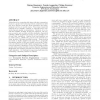Free Online Productivity Tools
i2Speak
i2Symbol
i2OCR
iTex2Img
iWeb2Print
iWeb2Shot
i2Type
iPdf2Split
iPdf2Merge
i2Bopomofo
i2Arabic
i2Style
i2Image
i2PDF
iLatex2Rtf
Sci2ools
118
Voted
MOBIHOC
2008
ACM
2008
ACM
Generic mobility simulation framework (GMSF)
Vehicular ad-hoc networks with inter-vehicular communications are a prospective technology which contributes to safer and more efficient roads and offers information and entertainment services to mobile users. Since large real-world testbeds are not feasible, research on vehicular ad-hoc networks depends mainly on simulations. Therefore, it is crucial that realistic mobility models are employed. We propose a generic and modular mobility simulation framework (GMSF). GMSF simplifies the design of new mobility models and their evaluation. Besides, new functionalities can be easily added. GMSF also propose new vehicular mobility models, GIS-based mobility models. These models are based on highly detailed road maps from a geographic information system (GIS) and realistic microscopic behaviors (car-following and traffic lights management). We perform an extensive comparison of our new GIS-based mobility models with popular mobility models (Random Waypoint, Manhattan) and realistic vehicular...
GIS-based Mobility Models | MOBIHOC 2008 | Realistic Mobility Models | Vehicular Mobility Models | Wireless Networks |
Related Content
| Added | 24 Dec 2009 |
| Updated | 24 Dec 2009 |
| Type | Conference |
| Year | 2008 |
| Where | MOBIHOC |
| Authors | Rainer Baumann, Franck Legendre, Philipp Sommer |
Comments (0)

